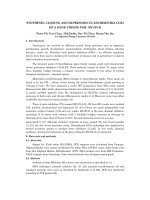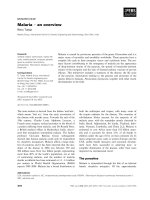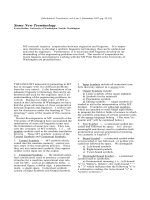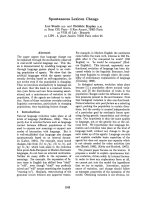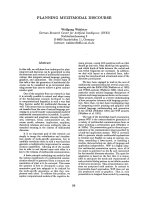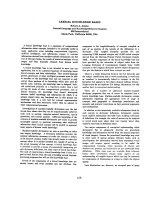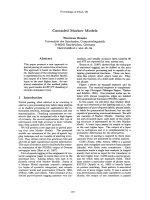Báo cáo " Concept lattice and adjacency matrix " ppt
Bạn đang xem bản rút gọn của tài liệu. Xem và tải ngay bản đầy đủ của tài liệu tại đây (138.65 KB, 5 trang )
VNU Journal of Science, Mathematics - Physics 24 (2008) 11-15
Concept lattice and adjacency matrix
Nguyen Duc Dat
1
, Hoang Le Truong
2,∗
1
Department of Mathematics, Mechanics, Informatics, College o f Science, VNU
334 Nguyen Trai, Hanoi, Vietnam
2
Institute of Mathematics, 18 Hoang Qu oc Viet, CauGiay, 10307, Hanoi, Vietnam
Received 26 October 2007; received in revised form 7 January 2008
Abstract. In this paper, we introduce a new encoding for a given binary relation, by using
adjacency matrix constructed on the relation. Therefore, a coatom of a concept lattice can
be characterized by supports of row vectors of adjacency matrix. Moreover, we are able to
compute a poly-sized sub-relation resulting in a sublattice of the original lattice for a given
binary relation.
1. Introduction
Lattices have given rise to much interest for the past years, first as a powerful mathematical
structure (see e.g. Birkhoff’s work from 1967), then as useful in applications such as exploiting
questionnaires is Social Sciences (see e.g. Barbet and Monjardet’s work from 1970 [1]). Galois
lattices were later widely publicized and studied by the large body of work done by Wille and Granter
and the many researchers who worked with them, under the name of concept lattices in a much more
general context (see e.g. [2]).
Nowadays, concept lattices are well-studied as a classification tool (see [2]), are used in several
areas related to Artifical Intelligence and Data Mining, such as Data Base Management, Machine
Learning, and Frequent Set Generation (see e.g. [3-5]).
The main drawback of concept lattices is that they may be of exponential size. This makes it
impossible, in practice, to compute and span the entire structure they describe. It is thus of primeval
importance to be able to navigate the lattice efficiently, or to be able to define a polynomial sized
sub-lattice which contains the right information.
In this paper, we introduce a new encoding for a given binary relation, by using adjacency matrix
constructed on the relation. Therefore, a coatom of a concept lattice can be characterized by supports of
row vectors of adjacency matrix. Moreover, we are able to compute a poly-sized sub-relation resulting
in a sublattice of the original lattice for a given binary relation and we used the main results in this
paper to determine the concept lattices or a sublattice of given concept lattice which satisfies the above
problem.
The paper is organized as follows: Section 2 gives some preliminary notions on concept lattices.
In section 3, we give main results.
∗
Corresponding author. E-mail:
11
12 N.D. Dat, H.L. Tru ong / VNU Journal of Science, Mathematics - Physics 24 (2008) 11-15
2. Preliminaries
In this section, let us recall the notion of concept lattice as far as they are needed for this paper.
The definitions in this section are quoted from [5]. A more extensive overview is given in [3]. To
allow a mathematical description of extensions and intentions, concept lattice starts with a (formal)
context.
Definition 2.1. A formal context is a triple K := (G; M; R) where G and M are sets and R ⊆ G×M
is a binary relation. The elements of G are cal led objects an d the elements of M attributes. The
inclusion (g; m) ∈ R is read ”object g has attribute m”. For A ⊆ G, we define
A
′
:= {m ∈ M |∀g ∈ A : (g; m) ∈ R}
and for B ⊆ M, we define dually
B
′
:= {g ∈ G|∀m ∈ B : (g; m) ∈ R}.
We assume in this article that all sets are finite, especially G and M . A context K with |G| = k
and |M| = ℓ is called an k-by-ℓ context. The proofs of the following results are trivial therefore we
omit them.
Lemma 2.2. Let (G; M; R) be a context, A
1
; A
2
⊆ G sets of objects, and B
1
; B
2
⊆ M sets of
attributes. Then the fo llowing holds:
(1) A
1
⊆ A
2
⇒ A
′
2
⊆ A
′
1
and B
1
⊆ B
2
⇒ B
′
2
⊆ B
′
1
.
(2) A ⊆ A
′′
and B ⊆ B
′′
.
(3) A
′
= A
′′′
and B
′
= B
′′′
.
(4) A ⊂ B
′
⇔ B ⊆ A
′
⇔ A × B ⊆ R.
Definition 2.3. A for mal concept is a pair (A; B) with A ⊆ G, B ⊆ M, A
′
= B and B
′
= A. (This
is equivalent to A ⊆ G and B ⊆ M being maximal with A × B ⊂ R.) A is called extent and B is
called intent of the concept. The set of all concepts of a formal context K together with the partial
order (A
1
; B
1
) ≤ (A
2
; B
2
) ⇔ A
1
⊂ A
2
(which is equivalent to B
2
⊆ B
1
) is called concept lattice of
K and denote by L(R) = L(G; M; R).
Such a lattice, sometimes refered to as a complete lattice, has a smallest element, called the
bottom element, and a greatest element, called the top element.
An element (A
1
; B
1
) is said to be a predecessor of element (A; B) if A
1
⊂ A. An element
(A
1
; B
1
) is said to be a ancestor of element (A; B) if A
1
⊂ A and there is no intermediate element
(A
2
; B
2
) such that A
1
⊂ A
2
⊂ A. The ancestors of the top element are called coatoms.
Let K := (G; M; R) and K
′
:= (G
′
; M
′
; R
′
) be two contexts. We call K and K
′
isomorphic,
and write K
∼
=
K
′
, if there exists two bijections ϕ : G → G
′
and ρ : M → M
′
such that (g; m) ∈
R ⇔ (ϕ(g); ρ(m)) ∈ R
′
for all g ∈ G and m ∈ M.
Theorem 2.4. [The basic theorem of Concept Lattice [5]] The concept lattice of an y formal context
(G; M; R) is a complete lattice. For an arbitrary set {(A
i
; B
i
)|i ∈ I} ⊆ L(G; M; R) of formal
concepts, t he supremum is gi ven by
i∈I
(A
i
; B
i
) = ((
i∈I
A
i
)
′′
,
i∈I
B
i
)
N.D. Dat, H.L. Truong / VNU Journal of Science, Mathematics - Physics 24 (2008) 11-15 13
and the infimum is given by
i∈I
(A
i
; B
i
) = (
i∈I
A
i
, (
i∈I
B
i
)
′′
).
A complete lattice L is isomorphic t o L(G; M ; R) iff there are mappings γ : G → L and µ : M → L
such that γ(G) is supremum-dense and µ(M) is infimum-dense in L, an d
gRm ⇔ γ(g) ≤ µ(m).
In p articular, L
∼
=
L(L; L; ≤).
The theorem is less complicated as it first may seem (see [5]). We give some explanations
below. Readers in a hurry may skip these and continue with the next section.
The first part of the theorem gives the precise formulation for infimum and supremum of arbitrary
sets of formal concepts. The second part of the theorem gives (among other information) an answer
to the question if concept lattices have any special properties. The answer is ”no”: every complete
lattice is (isomorphic to) a concept lattice. This means that for every complete lattice we must be able
to find a set G of objects, a set M of attributes and a suitable relation R, such that the given lattice is
isomorphic to L(G; M; R). The theorem does not only say how this can be done, it describes in fact
all possibilities to achieve this.
3. The main results
In the section we assume that K := (G; M; R) is a context with G = {g
1
, . . ., g
k
} and
M = {m
1
, . . ., m
ℓ
}. The adjacency matrix X = (a
ij
)
ℓ×k
of a context K := (G; M ; R) is defined by
a
ij
= 1 if (g
j
; m
i
) ∈ I and a
ij
= 0 otherwise. We denote by X
K
the adjacency matrix of a context
K. Then we denote by v
i
the i
th
row vector of the adjacency matrix X
K
and by V (K) the set of row
vectors of the adjacency matrix X
K
. For a vector v = (x
1
, . . ., x
k
) of V (K), Supp(v) = {i | x
i
=
1} ⊆ [1, k] = {1, . . ., k} and conversion for a subset Z of [1, k], we denote by v
Z
the vector in V (K)
such that Z = Supp(v
Z
). For a subset A of G, we denote by
A = {i | g
i
∈ A} and conversion for a
subset Z of [1, k], we denote by A
Z
the subset of set G such that Z =
A
Z
.
Examble 3.1. Let a binary relation between set G = {g
1
, g
2
, g
3
, g
4
, g
5
} and M = {m
1
, m
2
, m
3
, m
4
}
be the below table. Then the row vector v
2
= (1, 1, 0, 0, 0) and Supp(v
2
) = {1, 2}. Let Z =
{2, 3, 4} ⊆ [1, 5] then A
Z
= {g
2
, g
3
, g
4
}.
g
1
g
2
g
3
g
4
g
5
m
1
0 1 1 0 0
m
2
1 1 0 0 0
m
3
1 0 1 1 1
m
4
1 0 0 1 1
Now by Theorem 2.4, every vector of V (K) is attached to a unique concept. Let K :=
(G; M; R) be some formal context. Then for each vector v of V (K) the corresponding a concept is
ϕ(v) := (A
′′
Supp(v)
; A
′
Supp(v)
).
Lemma 3.2. Let K := (G; M; R) be a context. Then f or a ll vectors v of V (K),
A
′′
Supp(v)
= A
Supp(v)
.
14 N.D. Dat, H.L. Tru ong / VNU Journal of Science, Mathematics - Physics 24 (2008) 11-15
Proof. The inclusion A
Supp(v)
⊆ A
′′
Supp(v)
is trivial. Assume that g ∈ A
′′
Supp(v)
such that g ∈ A
Supp(v)
.
Then since g ∈ A
′′
Supp(v)
and (A
′′
Supp(v)
; A
′
Supp(v)
) is a concept, we have {g} × A
′
Supp(v)
⊆ R . Note
that the vector v corresponding with an element m of M and moreover m ∈ A
′
Supp(v)
. Therefore
(g, m) ∈ R and so that g ∈ A
Supp(v)
, a contradiction. Hence A
′′
Supp(v)
= A
Supp(v)
as required.
Let v = (x
1
, . . ., x
k
) and w = (y
1
, . . y
k
) be two vectors in R
k
. Then we denote by v
2
=
x
2
1
+ . . . + x
2
k
and vw = x
1
y
1
+ . . . + x
k
y
k
.
Proposition 3.3. Let X be a subset of coatom of a concept la ttice L(R). Assum e that a vector
v
i
satisfies the condition v
2
i
= max
j=1, ,k
{v
2
j
| Supp(v
j
) ⊆ In(X) =
(A;B)∈X
A}. Then the concept
(A; B) corresponding with v
i
is a coatom of L(R). Proof. Assume that (A; B) is not a coatom.
Then there exists a concept (A
1
; B
1
) such that A ⊂ A
1
. Let m
t
∈ B
1
. Since (A
1
; B
1
) is a concept,
we get that A
1
× {m
t
} ⊆ R. Then A
1
⊂ A
Supp(v
t
)
and so that
A = Supp(v
i
) ⊂ Supp(v
t
). Since
Supp(v
i
) ⊆ In(X ), we have Supp(v
t
) ⊆ In(X ). Hence, v
2
i
< v
2
t
and Supp(v
t
) ⊆ In(X ) in
contradiction by v
2
i
= max
j=1, ,k
{v
2
j
| Supp(v
j
) ⊆ In(X)}. Thus (A; B ) is a coatom of L(R).
Theorem 3.4. We use the above notati on. Then the following two statements are equi valent.
(i) A concept (A; B) is a coatom of L(R).
(ii) Vector v = v
A
satisfies the condition Supp(v) ⊆ Supp(v
i
) for all vectors v
i
such that
v
2
i
> v
2
.
Proof. (i)⇒ (ii) A concept (A; B) is a coatom. Let v = v
A
. Then A ⊆ A
1
for all A
1
= ∅ and A
1
is
a extent of any concept. By Lemma , if a vector v
i
satisfies v
2
i
> v
2
, then Supp(v
i
) ⊆ Supp(v).
(ii)⇒ (i) Let v be a vector such that Supp(v) ⊆ Supp(v
i
) where a vectors v
i
satisfies v
2
< v
2
i
.
Assume that a concept (A; B) where A = A
Supp(v)
is not a coatom. Then there exists a concept
(A
1
; B
1
) such that A ⊂ A
1
. Let m
t
∈ B
1
. Since A
1
× B
1
is a concept, we have A
1
× {m
t
} ⊆ R.
Therefore A
1
⊆ A
Supp(v
t
)
. Then we obtain Supp(v) ⊂ Supp(v
t
), and so that v
2
< v
2
t
, a contradiction.
Hence (A; B) is a coatom.
Corollary 3.5. Let (A; B) be a coatom of lattice L(R). Then we have
v
2
A
= max{v
2
| Supp(v) ⊆ Supp(v
i
) for all v
2
i
> v
2
A
and v ∈ V (K)}.
Proof. Put C = {v | Supp(v) ⊆ Supp(v
i
) for all v
2
i
> v
2
A
; v ∈ V (K)}. Since (A; B) is a coatom
by Theorem , we obtain Supp(v
A
) ⊆ Supp(v
i
) where a vector v
i
satisfies v
2
i
> v
2
A
. Therefore
v
2
A
≤ max
v∈B
v
2
. For all v ∈ C, v
2
≤ v
2
A
, we have max
v∈B
v
2
≤ v
2
A
. Hence v
2
A
= max{v
2
| Supp(v) ⊆
Supp(v
i
) for all v
2
i
> v
2
A
and v ∈ V (K)}, as required.
Note that a vector v ∈ V (K) corresponds with a concept which is coatom or without. Moreover,
two vectors v
i
and v
j
are different but they correspond with a same concept.
Corollary 3.6. Let v and w be two vectors in V (K) such that A
Supp(v)
and A
Supp(w)
are two extents
of any coatoms . Then the following two statements are equivalent.
(i) Vecto rs v and w correspond with a same coatom.
(ii) Supp(v) = Supp(w).
(iii) v
2
= w
2
= vw.
Proof. (i)⇔ (ii) and (ii)⇒ (iii) are trivial.
(iii)⇒ (i): Since entries of vectors v and w are 0 or 1 if Sup p(v) ⊆ Supp(w) then v
2
> vw. Therefore
Supp(v) = Supp(w ).
N.D. Dat, H.L. Truong / VNU Journal of Science, Mathematics - Physics 24 (2008) 11-15 15
Let V (R) = {v ∈ V (K) | v
2
= max
i∈[1,k]
v
2
i
} and X
R
= {(A
Supp(v)
; A
′
Supp(v)
)|v ∈ V (R)}.
Corollary 3.7. A set X
R
is a subset o f coatoms of the la ttice L(R).
Proof. Let (A; B) ∈ X
R
. Then a vector v
A
satisfies the condition v
2
A
= max
i∈[1,k]
v
2
i
}, and thus there
dosen’t exists a vector w such that w
2
> v
2
A
. By Theorem , a concept (A; B) is a coatom as required.
Example 3.8. Let K = (G; M; R) be as in Example . Then we have v
4
= (1, 0, 0, 1, 1) and so
that ϕ(v
4
) = ({g
1
, g
4
, g
5
}; {m
3
, m
4
}) is a concept of lattice L(R) by Lemma . Moreover, we have
v
2
1
= v
2
2
= 2, v
2
3
= 4 and v
2
4
= 3. Then by Theorem , we get that ϕ(v
4
) is not a coatom of this
lattice since Supp(v
4
) ⊂ Supp(v
3
). On the other hand, ϕ(v
2
) = ({g
1
, g
2
}; {m
2
}) is a coatom because
Supp(v
2
) ⊆ Supp(v
3
) and Supp(v
2
) ⊆ Supp(v
4
).
References
[1] M. Barbut, B. Monjardet, Ordre et classification, Classiques Hachette, 1970.
[2] B. Ganter, R. Wille, Formal Concept Analysis, Springer, 1990.
[3] M. Huchard, H. Dicky, H. Leblane, Galois lattices as framework to specify building class hierarchies algorithms,
Theoretical Informatics and Applications, 34 (2000) 521.
[4] J.I. Pfaltz, C.M. Taylor, Scientific Knowledge Discovery thorough Interative Trasformation of Concept Lattices, Worshop
on Discrete Mathematics for Data Mining, Proc. 2nd SIAM Workshop on Data Mining Arlington (VA), April 11-13,
2002.
[5] R. Wille, Restructuring lattice theory: an approach based on hierachies of concepts, Ordered sets. (1982) 445.
[6] G. Birkhoff, Lattice Theory, American Mathematical Society, 3rd Edition, 1970.
